
History of Flight
- 1. By Michaela - Grade 4
- 2. Kites need wind to fly and because there are many kinds of winds there are many kinds of kites to suit them. Most kites fly in gentle winds with speeds between 8 and 12 miles per hour. Kites are heavier than air and must be able to overcome gravity. They use the air flowing across their surfaces to give them an upward force. There are three main forces at work on a kite. These are gravity, lift, drag.
- 3. The first to make a hot air balloon were the Montgolfier brothers. The first hydrogen balloon, the Charleire, was inflated in August 1783. The very first passengers were a duck, rooster and a sheep. The first human passengers went up in September 1783. There is a gas burner that heats the air to 100 degrees Celsius. The hot air is lighter and less dense than the cool air around the balloon. The heated air causes the balloon to rise. When the air inside the balloon cools, or when the hot air is let out, the balloon goes down.
- 7. Step 1: Draw the body. Step 2: Cut out the body. Step 3: Trace the body.
- 8. Step 4: Test the plane. Step 5: Test again because it fell in the water.
- 9. Step 6: Use the glue gun because it broke. Step 7: Test again after the glue dried. Step 8: The plane can have a sun bathe
- 10. 1. Flyalot.com 2. The kite book- by Norman Shmidtt 3. You Tube- Hot Air Balloon History 4. www.air-ventures.co.za 5. www.hubpages.com 6. About.com Inventors